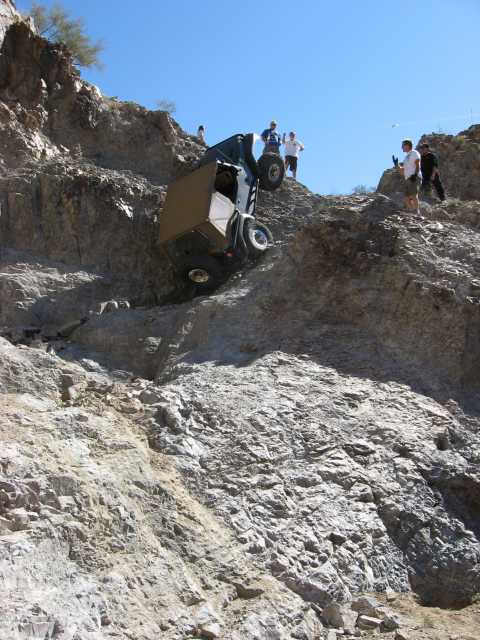
The location is a 30 foot waterfall at the start of Copperhead Trail near Lake Havasu City, Arizona. That is Lady and I working our way to the top. I have only two tires touching rock at that point, the driver front and the passenger rear. The winch is tied off to a winch line extension that goes more than 100′ to an anchor point.
And right about here…..I was saying to myself…..”Lady, don’t fail me now.” Fortunately for me, she did not. The following day, a vehicle didn’t make it to the top and from what I was told, the driver was very seriously injured. We hope the driver makes a complete recovery.
My point here? There are no second chances when it comes to this level of wheelin’. To all of the budget winch owners (you know who you are), you really need to ponder this situation for a bit and ask yourself if your bargain basement recovery system is honestly up to the task. Will you literally bet your life on it working when you most need it?
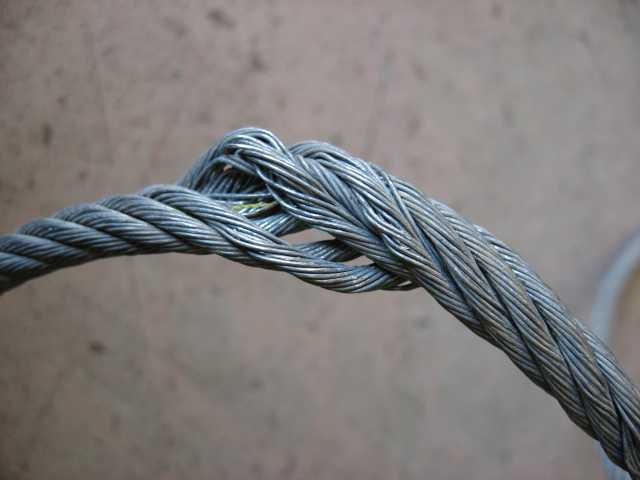
That same question needs to be asked in regards to your winch cable too. Your recovery system is no better than its weakest link. A top quality winch with damaged cable doesn’t make for a great combination. Does your steel winch cable have one or more of these along its length? If so, you are past due to replace your cable. I’ve seen much worse on winches in service out on the trail. Not good at all.
Even if your steel winch cable doesn’t have any damaged areas, replacing it with synthetic winch line eliminates some excess pounds from your vehicle’s bumper area. If fact, if you replace 100′ of 3/8″ steel cable with 100′ of synthetic line, you will be getting rid of 26 pounds of cable and replacing it with just 3.6 pounds.
While the weight savings is a plus, the BIG advantage to running synthetic winch line is the increased safety aspect. Due to its light weight construction, the synthetic line stores virtually no energy while under tension from the winch. This means that if the line should fail, it literally falls to the ground. It is very much like throwing a napkin through the air….it goes a couple of feet and falls to the ground. One thing to remember though is that if you have a hook on the end of the line (let’s say you are attached to your tree saver and the tree saver fails), then that hook will not simply drop to the ground. It would be along the same lines as putting a rock in that napkin and then throwing it…..it will go much further before hitting the ground.
The heavier steel cable stores a significant amount of energy when put under heavy tension. I’m sure you’ve seen people lay blankets, tarps, and even sand bags across the steel cable as a safety precaution against it failing. None of this is needed with synthetic winch line. That level of danger is just not there.
While you could stand next to synthetic winch line while winching, it’s a good idea to treat it with the same respect as you would steel cable when ever possible. If your tree saver breaks, you don’t want to be right there when that rock in the napkin goes by. I know that many of you wheel with children…..wouldn’t it be great knowing that your child is much safer from the possibility of a failed winch cable? How can you put a price on that?
OK….so I’ve stood on the soap box long enough. Time to get on with this and see just what all is available.
Viking Offroad Synthetic Winch Line
Several years ago, Jon Jonnson founded Winchline.com, a division of Gourock, to address the need for quality recovery products for you and me. Gourock has been in the business of making ropes, netting, and sails for the maritime industry since 1736. In 1994, Jon acquired Gourock and has since expanded the legacy of reliable products into the offroad market. Jon calls Washington state home now and can be seen in many of the western states wheeling with family and friends as well as making the rounds at the rock crawling competitions.
After exchanging several e-mails with Jon, I knew it was time to upgrade my existing recovery system. I also discovered that there were a few things I was doing wrong (not surprising). His practical experience helped answer several questions and the time he took to explain things was greatly appreciated. I quickly discovered he is dedicated to his business and his customers as well. By the time you read this, I will have met up with Jon at the Globe, Arizona WERock rock crawling event. He decided to “swing by” on his way to Moab, Utah for the Easter Jeep Safari. Gotta love the guy’s travel agent!
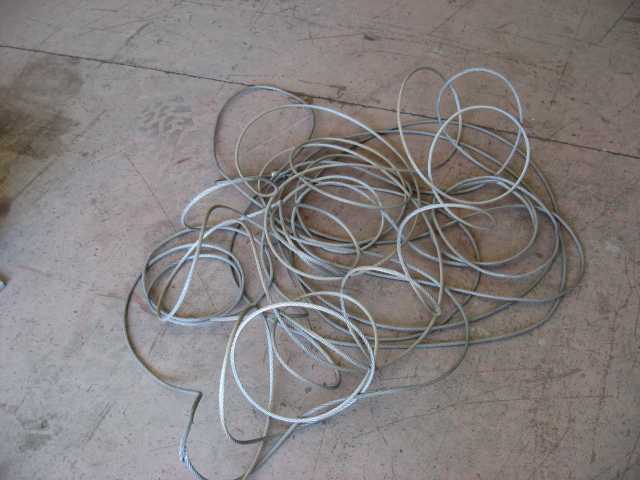
The first thing I had to do was to strip the steel cable off of my Warn 9000i winch. That part was pretty easy. Grab a pair of leather gloves (you do use leather gloves with your steel cable, right?), put the winch in free spool, and start pulling on the cable.
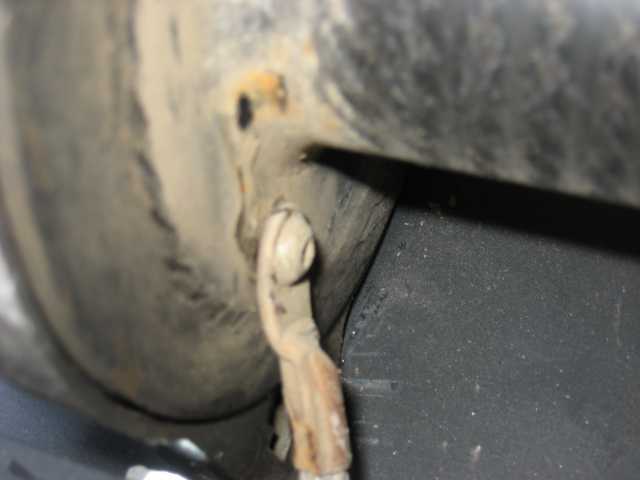
For those who have not spooled their Warn winch cable down to the very end (certainly NOT a good idea when you are winching with it), there is a small button head screw that secures the end of the cable to the side of the winch drum. Remove the screw and your cable is free from the winch.
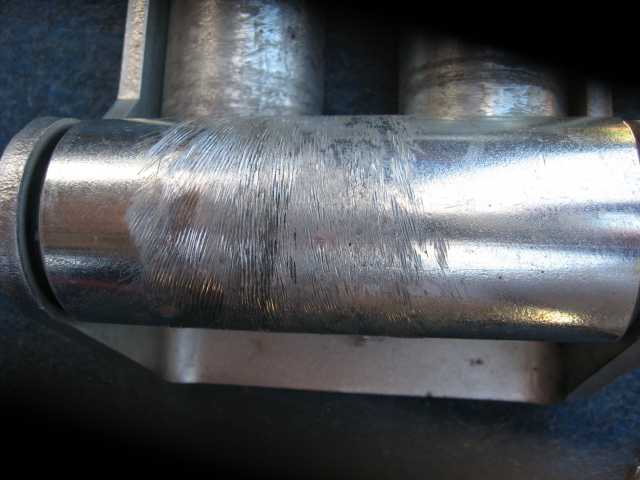
Before I start spooling on the new synthetic line, there are some other things that need to be covered. The winch fairlead is a topic that Jon and I discussed at length. The above photo is the roller fairlead from my winch. As you can see, it’s a little “buffed” from the steel cable and some high tension off-angle pulls.
Now we all know that everyone on the internet says you use roller fairleads for steel cable and aluminum fairleads for synthetic line. Jon informed me that I could use my roller fairlead as long as it didn’t have any significant gouges or burrs on it that would in fact cut into the line. I was hesitant about not switching to an aluminum fairlead but he assured me my roller fairlead would work with his winch line. Given the fact that Winchline.com stocks a nice looking $70 aluminum fairlead, I was willing to give my current fairlead a try. Keeping the cost of your recovery upgrade project under control is good thing.
The other “pre-spooling” subject that warrants some attention is your winch plate. I’ve been using the same winch plate since I got my Warn winch quite a few years ago. I couldn’t tell you the brand as I bought the plate used….but it bolts square to the TJ’s frame rails and has the requisite mounting holes for the winch. What I hadn’t given any thought to was the cable slot in the front of the mounting plate that your winch line runs through. Once again, Jon’s industry experience pays off.
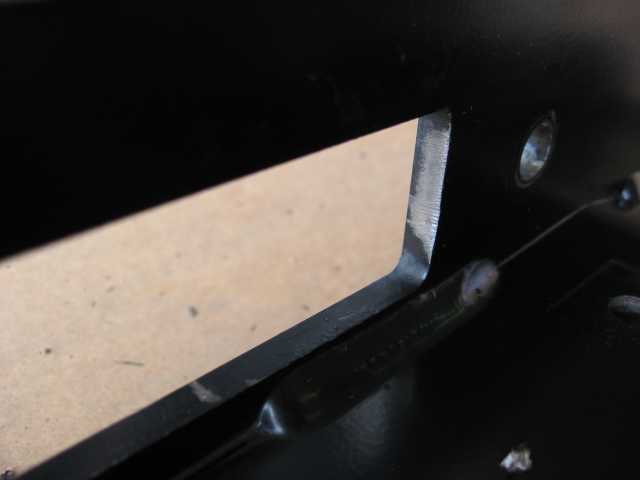
As you can see in the photo, there is evidence of the steel cable rubbing the side of the cable slot. A few other close-up inspections finds this to be true on several other areas as well. While those very squared off edges may not affect the steel cable, it is not something you want your synthetic line rubbing against. What to do?
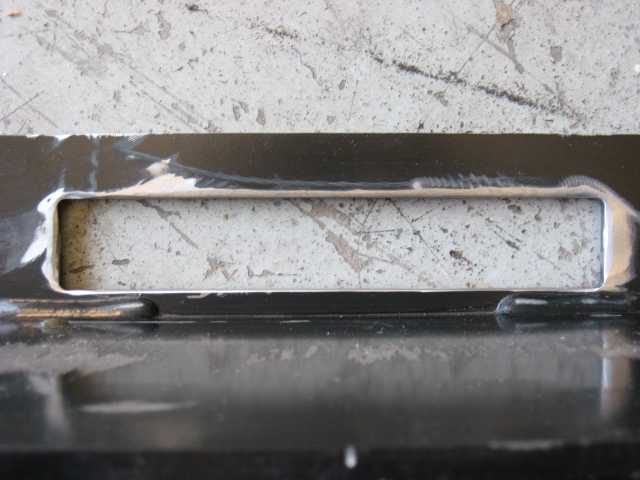
I broke out my right angle grinder that still had a sanding disc on it. A few minutes with it put a pretty good bevel on those edges. I finished them off with some medium grit emery cloth and applied a couple layers of rattle can black to the plate. An ungloved finger was used to ensure I had gotten all the nooks and crannies and that I had a smooth surface. Note to any winch plate manufacturers that may be in the reading audience…..”Make those cable slots a bit larger to avoid contacting the line!” In most cases, it won’t be an issue, as evidenced by most of the powder coating still on the inner surfaces of the cable slot. But none the less, check it out and bevel that surface if you think there is even a remote possibility of the line contacting the winch plate.
Viking Offroad Synthetic Winch Line
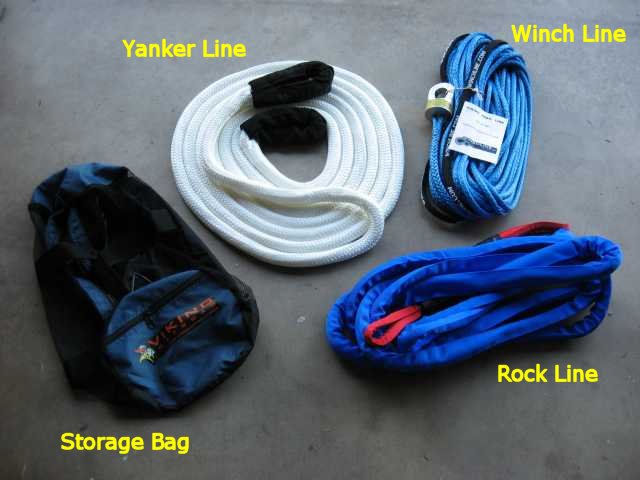
So what is the well dressed TJ vehicle recovery setup sporting for the upcoming wheelin’ season? You start with 100 feet of Viking 3/8″ Trail Line (winch line) which is made from Samson’s 12-strand AmSteel Blue (12 strand single braid) synthetic line. If blue is not your favorite color, you can opt for black, silver, green, yellow or orange too. Adorned with a Winch Safety Thimble (more on that later), your winch line will be the envy of every winch on the waterfall! For those that are number crunchers, this 3/8″ Viking line is rated at 19,600 pound breaking strength. That is more than twice the rated pull of my Warn 9000i winch. The line I got has 10′ of 7/16″ heavy duty polyester line protector. The line protector can be slid up and down the line as necessary to provide abrasion protection for the synthetic line.
No recovery system (especially those of us living in the rocky west) would be complete without a 25′ Rock Line. What is a rock line? Think of it as a tree saver on steroids. Here in central Arizona, we don’t have many trees that provide a good anchor point. Rocks we got….and lots of them too.
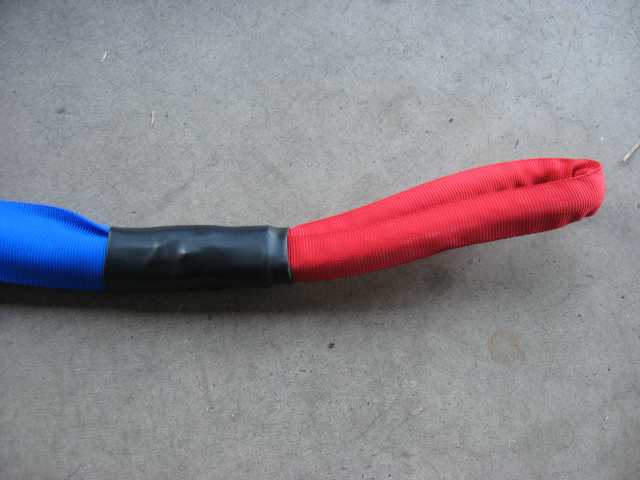
The rock line is made from 3/8″ AmSteel Blue line and protected by a 1/2″ braided polyester jacket that lies under the blue covering and ends just under the black heat shrink (in the above photo). To keep debris out of the line, Jon covers the entire line with a tightly braided nylon sleeve (that blue covering you see in the photo). The loops at the end of the rock line are covered in a red nylon sleeve to help protect them too.
During one of our discussions, Jon informed me that the 30’x2″ yellow strap that I admitted to using (to go around the car sized rocks for an anchor point) was NOT the right tool for the job. The yellow straps (I’ve seen a lot of them in use out here on the trail) are designed to stretch under load and so make for a poor anchor line. Remember, we do want to minimize the stored kinetic energy in the line while it is in use. OK….guilty as charged…..and I won’t be using a yellow strap as my anchor point any more.
Speaking of yellow straps (I always carried one to help those “other” vehicles get unstuck!), the Yanker Line (shown at the top of the page) completes the recovery trio. Now this line is all about stretching. Made from 100% Premium DuPont Nylon Double Braid, this line will typically stretch 10~20% while yanking a vehicle out of a stuck situation. It will stretch over 30% prior to breaking. I got the 7/8″x30′ version that is rated at 28,300 pounds. Jon recommends a rating of 5 to 7 times the vehicle’s weight for a properly sized Yanker Line. Too light, you run the chance of it breaking. Too heavy and you won’t get the benefits of the line’s “stretchy” factor.
The Storage Bag is made from a fish net looking material that provides good ventilation should your Rock or Yanker lines get wet during use. (I probably won’t see much damp line syndrome here in Arizona but I know for a fact that some of you can’t find a dry 4×4 trail to save your soul. LOL!) Several designer colors to complement your other recovery gear are available.
OK….so I took the liberty “presenting” the gear I got with a bit of humor mixed in. After re-reading the opening page of this article, I realized I may have dumped on some of you and while that was not my intention, I still stand behind what I said. Your recovery gear is every bit as important as the rest of your vehicle mods. You are going to rely on it the most after you failed to get from point A to point B, right? Right!
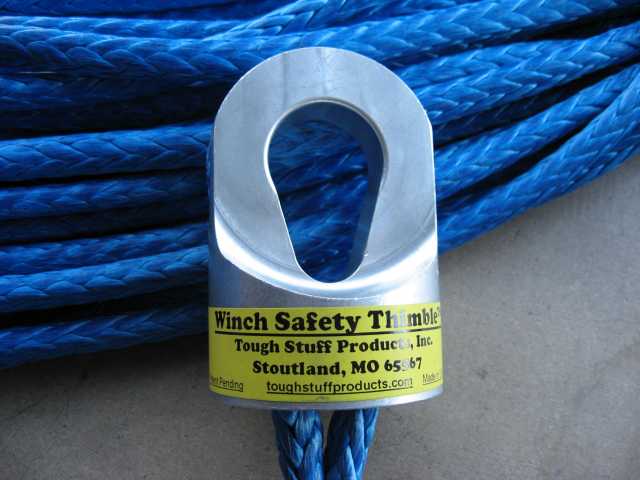
Before I get too far from the things I wanted to cover on this page, I need to mention this little gizmo. It is the Winch Safety Thimble produced by Tough Stuff Products, Inc. I have a number of this company’s unique products on my TJ. This one is an absolute must if you own a winch. OK….so I am a bit biased and just because I know one of the owners, Blaine Johnson, that still doesn’t take away from the significance of this winch line add-on.
Gone are the days of the winch hook. Gone are the days of having the hook fall out of the loops on your tree saver. Gone are the days of holding on to the hook and feeding it (and your fingers) into the fairlead. Yeah, we all should know what we shouldn’t be doing while operating a winch…..but I’ve seen it on the trail none the less.

The Winch Safety Thimble won’t pull through your roller or hawse fairlead. It is rated for winches up to 15,000 pounds and works with all common D-rings and shackles. The Safety Thimble was designed to fully protect the 5/16″~3/8″ line where it wraps around the thimble’s support groove. This groove keeps the line safe from drops onto the rocks. And for those watching their weight, you’ll save about 50% of the weight of a safety winch hook. You can order your synthetic line from Jon with the Winch Safety Thimble attached. If you already have synthetic line, get in touch with Jon and order a Safety Thimble. You can attach it to your existing line in about 10 minutes by following the directions available at Winchline.com.
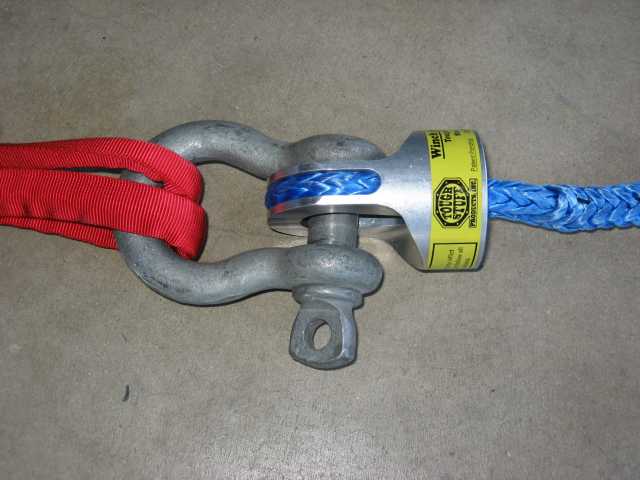
Here is a photo of the Rock Line safely and properly attached to the Viking Trail line. I don’t care how hard you try, once the bolt is threaded into the shackle, this isn’t going to come apart no mater how much slack or tension your winch line experiences. It doesn’t get any safer than this!
Viking Offroad Synthetic Winch Line
OK….it’s time to attach the new Viking Trail Line to the Warn winch and get it spooled onto the drum.
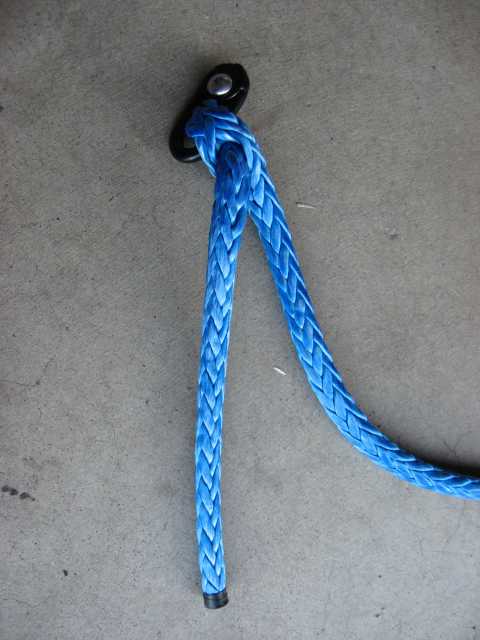
Jon provides well written instructions (both with the product and on Winchline.com) for attaching the line to the winch. I can’t say for certain that every brand of winch is covered in these instructions, but he has the big name brands covered and most of the inexpensive import winches copy the major manufacturers anyway. For my Warn 9000i, a small button head screw secures the line to the side of the drum. My Viking line arrived with a special drum attachment already installed…..all I had to do was supply my own Allen wrench. Depending on your brand of winch, you may need to remove this (refer to the instructions).
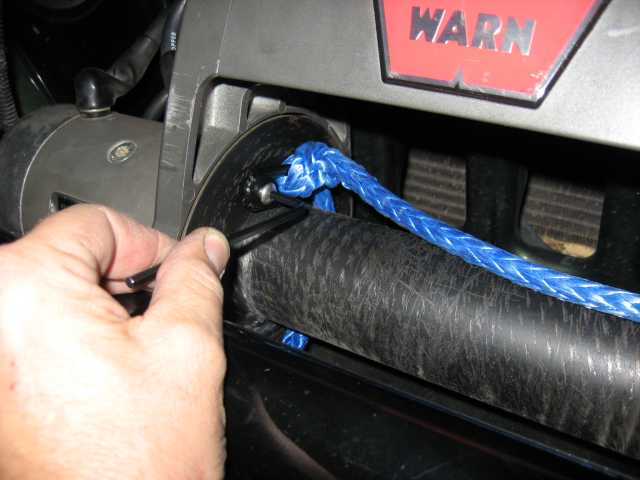
I fed the end of the winch line through the fairlead opening and under the drum. Next, I brought the line up and around the back side of the drum to the attachment point on the side of the drum. Using an Allen wrench, I secured the end of the line with the supplied screw.
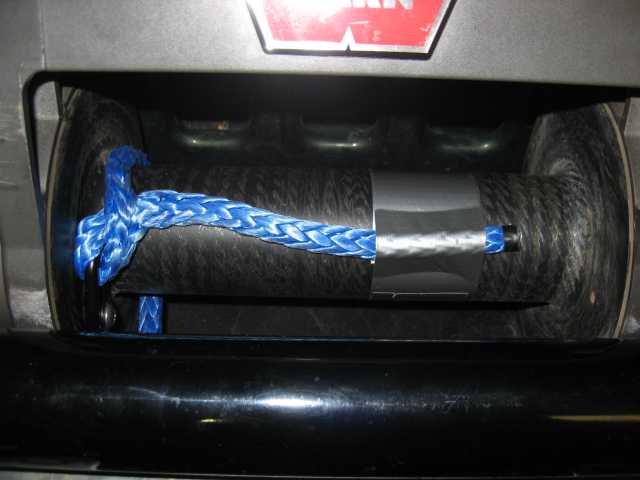
The “loose end” of the line is laid across the drum as shown above and duct tape is applied to secure it as shown. You know, a person has to appreciate the unlimited number of uses for duct tape. If duct tape could be eaten, it would be its own food group for sure!
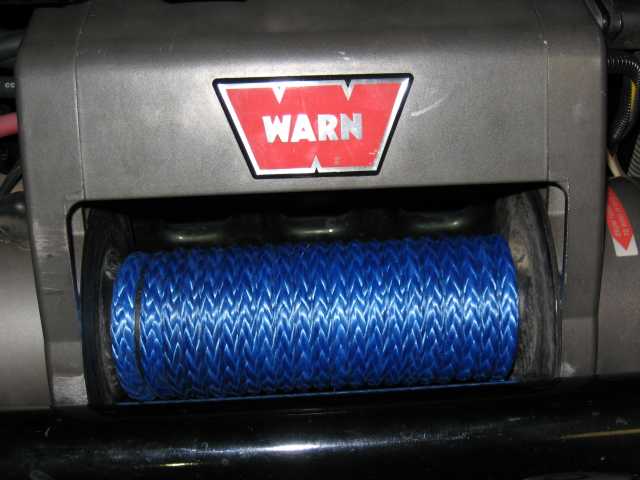
I plugged in my winch controller and proceeded to spool the first layer of winch line onto the drum. Since this part of the installation was being done at 8:30 PM in my garage, I didn’t have the opportunity to wind the line onto the drum under “moderate to high” tension as stated in the instructions. Once I get to the trail head and can use another Jeep as an anchor, I’ll spool out the line and repeat this part. Most folks, myself included, set the parking brake to create a reasonable amount of drag on the vehicle as they spool the new line onto the drum.
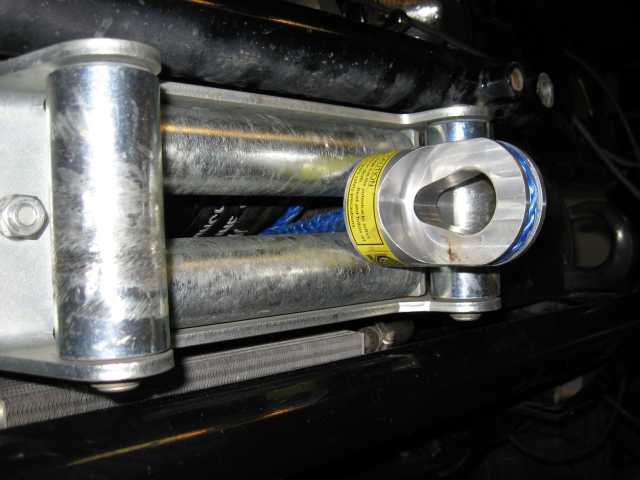
I proceeded to spool the line using as much tension as I could generate under the circumstances. 100′ of Viking line later, the Winch Safety Thimble bumped into the rollers just as it should.
Viking Offroad Synthetic Winch Line
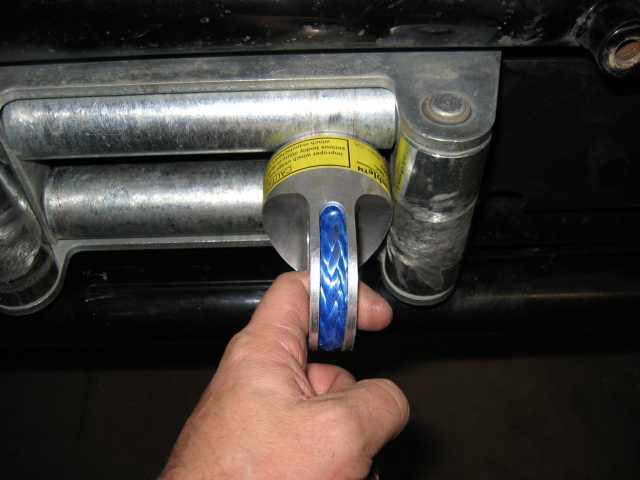
I took the opportunity to pose this photo so you could see the manner in which the safety thimble prevents your finger(s) from being sucked into the rollers. I suppose you could wrap your fingers around the back surface of the winch thimble, where it contacts the rollers, and in doing so manage to pinch yourself. If you do, I suggest you don’t tell anyone just how you managed to pull that one off…..I would be embarrassed to say the least.

With the Viking synthetic line spooled onto the drum, all that remained was the application of the Winchline.com decal. I have it on good authority that if you skip this step, there is a high probability that your vehicle recovery system will not perform as well as it should. You’ve gone this far…..don’t wimp out now!
With the safety thimble looped over one of the tow hooks, I was done and called this project a wrap! I’m looking forward to trying out the new line on the trail. Moab is a bit over 3 weeks away. Perhaps Donna and I will find something there to winch up and over.

Many thanks to Jon for his excellent customer service and a quality product. I appreciate the time spent answering my questions and providing options for the recovery equipment. As with many of my write-ups, I’ll try to provide an update further down the road when I get a chance to use this on the trail.
Good trails and remember to TREADLightly!
Synthetic Winch Line Failure
(the care and feeding of synthetic rope)
About a month after I installed my Viking Offroad synthetic winch line, it was time to go to Moab, Utah for the 7th Annual JeepsUnlimited Moab Run. This is a non-event trip that I look forward to attending every year as it gives me a chance to see my friends and always make new ones. With any luck, the 40ish Jeeps that participate usually do just fine, but every now and then, one will end up with a problem. This year, a nicely built Rubicon was winching up the last obstacle in Pritchett Canyon and rolled. Somewhere in the middle of this happening, a brand new, never used, 3/8″ Masterpull synthetic line failed under load.
Upon returning home, I checked into the local Jeep forum only to find that another local Jeeper suffered a synthetic winch rope failure over the weekend. This rope had been on his TJ for approximately two weeks and it was the second time it had been used.
OK…..there are lots of folks running synthetic winch line but to have two failures in a week by folks that are from my local area is somewhat alarming. What the heck was going on? I can see old abused rope failing but not brand new 3/8″ synthetic line.
I solicited the help of Jon Jonsson from Winchline.com as I wanted to know what caused these failures. After all, if I was going to trust my TJ on the end of a synthetic winch line while climbing a water fall, I wanted to make certain that I wasn’t going to see the same kind of results as my fellow Jeepers just had. I sent Jon links to both of the forum threads that were discussing the rope failures. The threads were populated with good quality photos (thank you people for NOT using those ridiculous camera phones!) and it was my hope that Jon’s vast experience in the synthetic rope industry would help shed some light on what was happening.
Let’s start with the incident where the winch line was being used for the 2nd time when it failed. It was first thought that the rope simply failed due to a manufacturing defect. Upon closer inspection, this was found not to be the case.
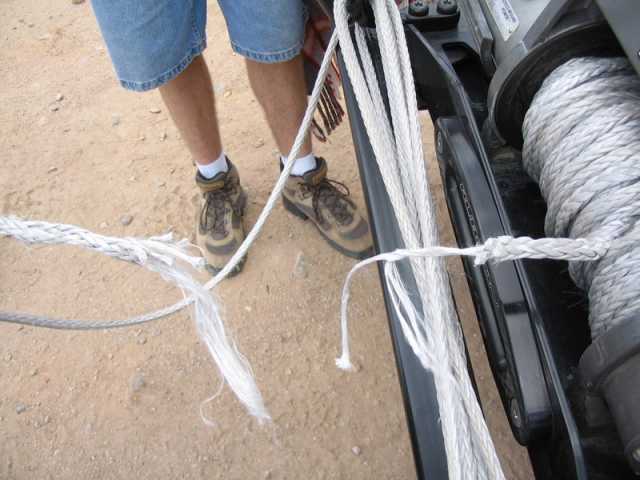
Here is a photo of that broken line and Jon’s comments concerning it:
“If this rope broke from overload the whole thing would look like the one strand on the left side that is all frayed, it looks like 11 of the 12 stands cut on the winch plate and then the last strand broke from overload since each strand has about 1000 – 1500 lbs of strength depending on size of rope.”
But how did the line get cut on the winch plate? Part of the answer lies in the above photo. If you look, you will see that the end of the broken line that is still wrapped on the winch is routed up and over the top of the drum. This line had been spooled onto the drum incorrectly. Because of this, it was weakened during its first use…..and when used a second time during a vehicle recovery, the additional damage it incurred was enough to cause a complete failure.
Let’s look at a couple of my famous drawings (ok, so I’ll admit that I am graphically impaired….which is why I always use my camera in my write-ups) to help explain what happened to the synthetic rope. The graphics depict a side view of the winch drum and that part of the winch mounting plate that holds either the Hawes or roller fairlead.
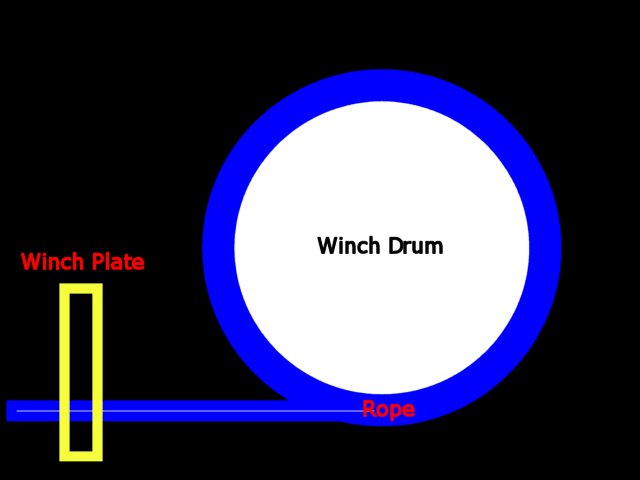
The above graphic shows the correct route the winch rope should take as it spools on and off the drum. Note that it is fed under the drum, not over the top of it. Given the relative position of the winch drum and the winch plate (which has a slot cut in it for the winch rope to feed through), the winch rope should be able to freely move back and forth through the slot in the winch plate without touching the edges of the plate. This means no friction and no cutting and the rope is maintained in good condition.
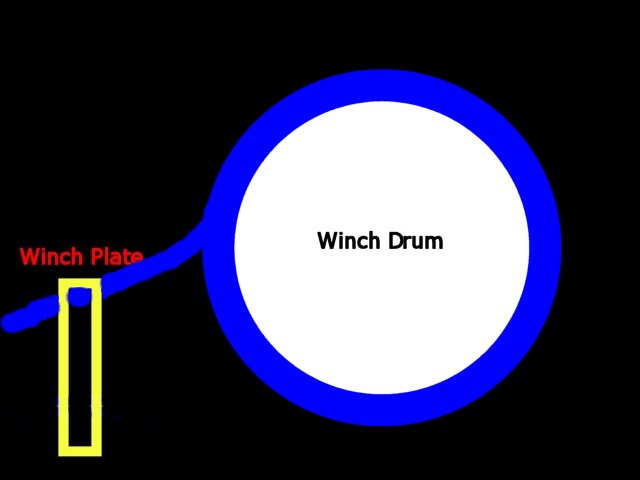
In this graphic, the rope as been incorrectly wrapped up and over the top of the winch drum. When the rope is fed under tension through the slot in the winch plate, it now rubs against the upper inside edge of the plate. This causes friction, then fraying, and sometimes quite quickly the cutting of the rope. From the rope’s perspective, it is no different than if you had tensioned it across a sharp rock while winching your vehicle…..and we all know that is NOT the proper manner in which to use synthetic rope.
What are the lessons learned from this paticular incident?
1. Always spool the rope onto the winch drum from the bottom. Some winch rope suppliers/sellers attach a tag, with a reminder to do this, to the end of the line. Unfortunately, not all of them do.
2. It is important to check your winch mounting plate to ensure it has adequate clearance for the synthetic rope. It is possible that the rope may still contact one of the edges as it passes through the slot. If it does, it will surely abrade the rope and cause it to fail. Jon explained this to me in length before I installed my synthetic line onto my winch.
3. After you are done winching, ALWAYS inspect your winch line (steel or synthetic) for damage. In this incident, it is possible that the owner may have discovered the frayed line and would have been able to take actions to prevent the subsequent failure.
For more information on installing synthetic winch rope, see my write-up.
When you are using your winch and there is a possibility that the rope will come in contact with a sharp rock or other object that can damage/cut the rope, you need to use a protective sleeve on the rope. Any quality synthetic winch rope will come with a heavy duty sheath (typidcally about 6’~10′ long) that can be slid up and down the length of the synthetic rope for proper positioning against a rock.
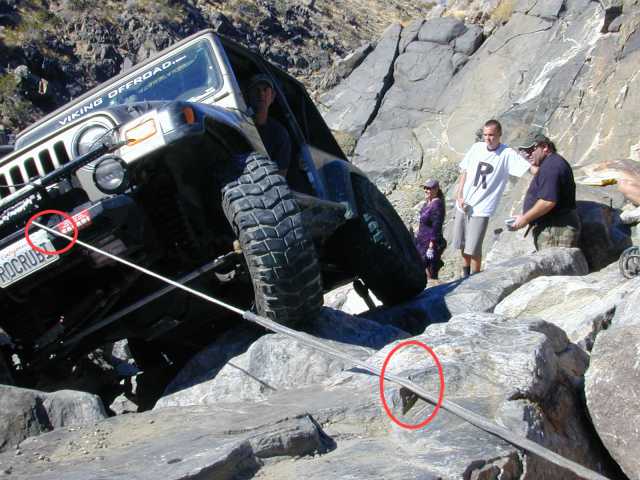
Jon provided me with this photo showing two spots where you would need to pay close attention to the rope while winching. I put a red circle around both of them. You can see the heavy duty protective sleeve (lower right corner of photo) on the winch rope and the circled area is where the rope would have been touching the rock were it not for the protector. When your synthetic line is in this kind of a situation, you MUST use the protective sleeve to prevent damage/failure to the rope. If you don’t have a sleeve, GET ONE NOW!
The second spot you should be aware of (in the above photo) is adjacent to the winch. It is very possible that your winch rope may rub on your bumper (and perhaps even the license plate) as depicted above. The bumper on this vehicle has very contoured edges/corners so they do not present a problem to the winch rope. This may not be the case for all bumper/winch mounting plate combinations.
Be sure you know where your line is going when you are doing an off-camber or non-straight pull winching session (like shown above). Your line may start out just fine but may end up rubbing against a sharp object before you are finished using the winch.
Synthetic Winch Line Failure
(the care and feeding of synthetic rope)
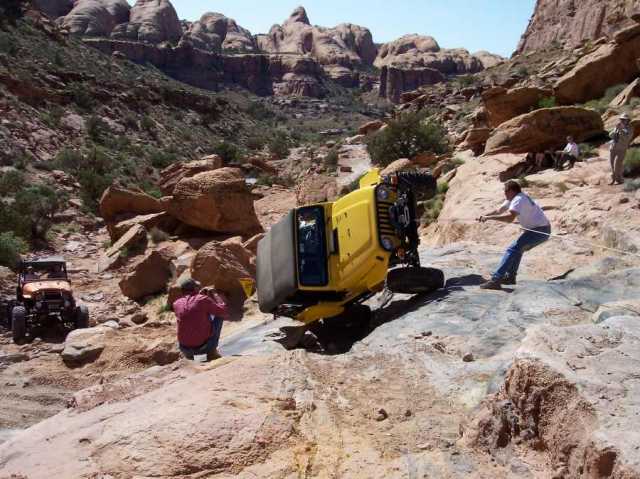
The other incident occurred while doing a non-straight pull up a long and difficult obstacle. The details surrounding this event were explained and discussed over some 7 forum pages. I’ll try to condense it down a bit.
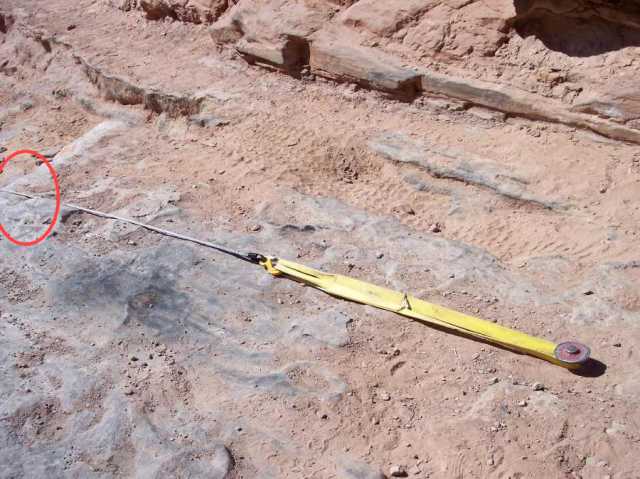
This was the Rubicon just before the line failure. We won’t go into the actions of the individual on the winch rope as he already stated in the forum thread that “I honestly can’t believe what I’m doing here…that’s gotta be high on the list of the dumbest things I’ve ever done.” I don’t think anyone will argue with him….it certainly is dangerous and then some.
From what I gleaned from the forum thread, the driver stopped winching at this point (to prevent the vehicle from being pulled over) and let winch line out. Apparently slack occurred in the winch line…..and then the vehicle moved backwards down the obstacle putting a shock load on the synthetic line. (at least that is what seems to have happened)
Should the line have failed at that point? We don’t know what the shock load was so it may have very well exceeded the working specs of the rope.
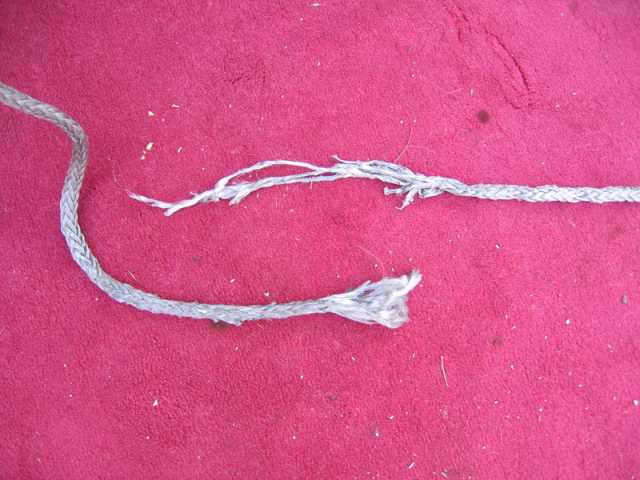
Here are the ends of the synthetic rope. Remember, this was its first time in use …..which was when it failed. See any similarities between this rope and that from the previous page? It failed about 5′ from the end of the rope.

This was the anchor point for the Yellow Rubicon. I circled a spot that was some 5′ from the end of the synthetic line. Notice that it is on rock and going over the edge of the rock. Given the high tension on the line, and the fact that the vehicle is below grade at this point, there is good tension on the line in a downward direction…..the kind that frays and cuts the synthetic line when against a sharp object.
There is no line protection in use at this trouble spot either. Major mistake!
While not part of the rope failure issue, I would like to comment about using the yellow tree saver strap around the in-ground anchor (an axle shaft put down a hole in the rock). I discussed this with Jon since he makes his own tree savers and Rocklines for his business. If the tree saver strap is made from nylon, it will stretch about 15% ~ 30% before breaking. This is far too much stretch for a winch point anchor. If the tree saver strap is made from polyester, it will stretch about 3% before breaking. While this is still 3 times more stretch than the Rockline I use, it is much safer than a nylon tree saver. After doing some research on a couple of web sites, it appears that Warn makes their snatch straps and tree savers out of nylon (they both have the same strength rating) while ARB shows different strength ratings for their straps and lists the tree saver as polyester construction.
Edit: I found out today that the two people that were injured in this winching incident were standing behind the above winch point. They both caught the backlash of the of tree saver recoiling when the line broke. One was seriously cut and the other ended up going to the hospital for x-rays on his leg. He’s been on crutches for a week. The hook apparently hit him and the cut was the result of being whipped with the line. The person that was holding the synthetic line (in a previous photo) near the front of the Rubicon suffered no injuries when the line broke.
So in summary…..if your tree saver is made from polyester, you don’t need to toss it….just be aware that it will store some energy and take appropriate safety steps. If your tree saver is made from nylon, I would be looking to replace it. A strap made from nylon would be a bad component for anchoring the winch rope.
The last thing I noticed in the thread was this last recovery photo taken after the yellow Rubicon was winched back onto it’s tires. Notice the long yellow snatch strap that is wrapped around the big rock (upper left hand corner of the photo)? That was used, if I am not mistaken, to hold a snatch block during the recovery. If I am correct on this fact, then that was also the absolute wrong strap to use for this action. That strap is designed to stretch quite a bit when put under tension. If something fails with all that stored energy in it, the results can be very bad….very, very bad. Rockline, which has <1% stretch, would be the correct line to use for a winch or snatch block anchor like this.
Jon sent me a couple of photos and I decided to add these to this write-up as well since they are all about line protection. He provides two different protectors for synthetic line with one of them being the heavy duty version.

I use the protector shown on the left in the photo. It can be easily slid up and down the length of the winch line. The heavy duty protector is shown on the right. It is quite a bit larger and does offer more protection. If you routinely winch in situations where the rocks edges are sharp and numerous, you may want to upgrade to the heavy duty version.

Here are the same two protectors. You can see the difference here very clearly. Yes, the heavy duty protector will take up more room on your winch drum….about 10′ of space to be exact. If you run 100′ of 3/8″ Amsteel blue, you’ll only get 90′ on the drum once you slide this protector over the winch line. Winchline.com is coming out with a new protector in a few months that can be kept in the recovery bag until needed. It will wrap onto the line for use and can then be removed and put back into the gear bag once you are done winching. Sounds like a very good idea to me.
I hope these last two pages have provided you with some insight as to the requirements for using synthetic winch line. Some view these as “downfalls” of the synthetic line. I don’t…..they are simply operational requirements that must be followed when using the product. No more nor no less than the requirements put on other components used in/on our vehicles…..using the correct fluid in your NV3550 tranny…..using the correct air pressure for your ARB air lockers…..adding the friction modifier to a clutch type LSD…..well, you get the point.
As always, if you have questions in regards to the products and components you use on your vehicles, check with the manufacturer and/or vendor for answers.
I’ll try to add more information regarding the use and care of synthetic winch rope as I get the chance.
In the mean time, good trails and remember to TREADLightly!
